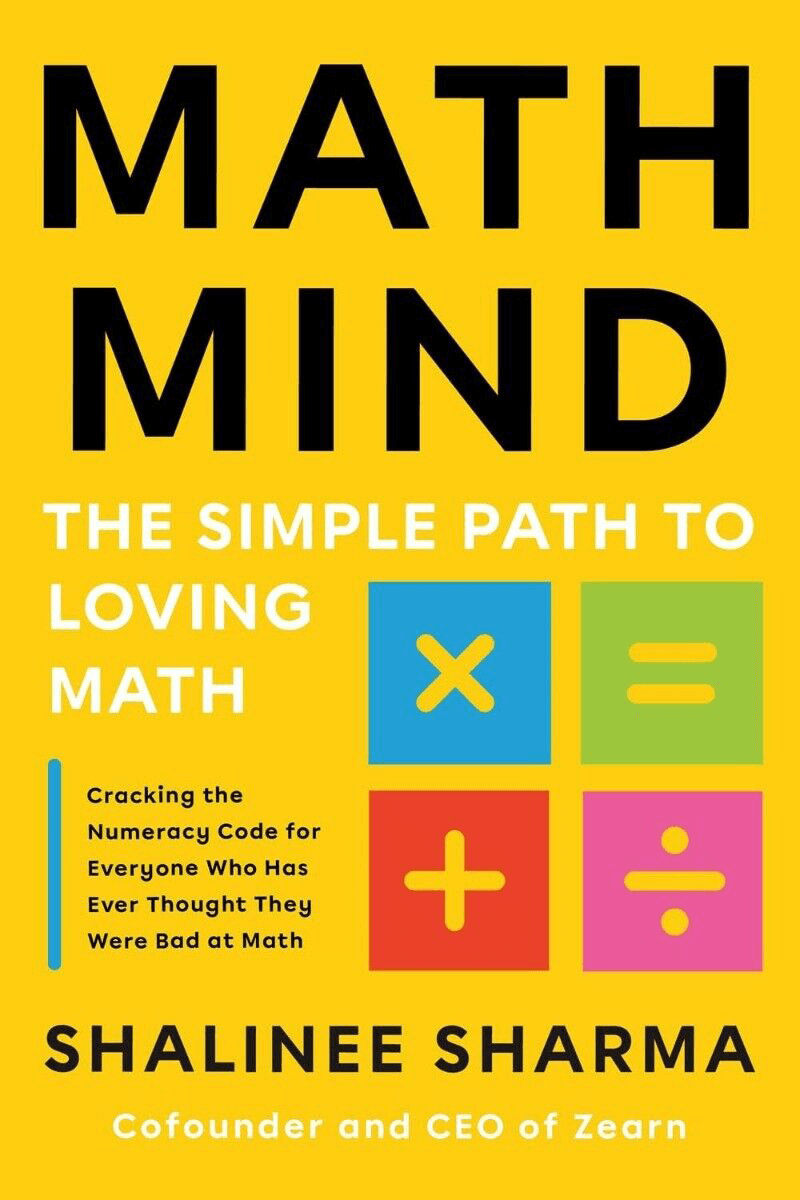
Early on in Math Mind: The Simple Path to Loving Math, Shalinee Sharma experiences a moment of doubt. After 13 years at Bain & Company, she cofounds Zearn, an educational nonprofit. Zearn wants to offer great math teaching free to any child. But Sharma and her cofounders immediately encounter an obstacle––one that has frustrated many an educational newcomer: there is no agreement about what great math teaching looks like. “There was no manual for what I wanted to do,” she writes. “I had to go a different way.”
This was in 2012. Since then, Zearn has evolved into a free digital mathematics curriculum and learning platform. Some teachers might pair students with a Chromebook and headphones for supplemental “Zearn time.” It can also be used as a standalone resource with self-paced videos, practice, and games. About 10 percent of elementary teachers across the country report using Zearn once or more a week, according to a 2023 RAND survey. Quite a few math problems have been solved on its platform—over 14 billion.

by Shalinee Sharma
Avery, 2024, $28.00; 288 pages.
In the past 12 years, Sharma has visited “thousands of classes” and reached some conclusions. Chief among these is that school is badly broken. “Our math education system makes learning math a hellish experience,” she writes. “Most kids hate math.” Her experience as CEO of Zearn suggests this suffering is needless. All kids can not only learn math but also love math, if supported properly by parents and educators. “It’s time that the adults get together and make that happen.” But how?
Sharma’s first big idea comes courtesy of none other than Carol Dweck, the Stanford psychology professor whose research on the benefits of cultivating a growth mindset in students now pervades U.S. classrooms. Sharma devotes a chapter to the importance of growth mindset and the related concept of stereotype threat. When teachers get these wrong, it can be disastrous for kids. Take Mr. Rockhill, Sharma’s mathematics teacher, who on the first day of high school melodramatically placed 18 desks out for 20 students. “At least two of us, he said—but probably more—wouldn’t make it,” Sharma recalls, creating a scene I thought existed only in fiction.
Next comes her favorite recommendation, the one she mentions to a “fabulously successful investor” who asks what Zearn has divined from its database of millions of students. Sharma tells the investor that it has learned to offer pictures (“especially brightly colored ones”) to students when they’re stuck. Educators typically refer to this (minus the colors) as the “Concrete, Pictorial, Abstract” approach, with roots in Jerome Bruner’s 1960s theories of instruction, which then inspired Singapore’s influential math curriculum work in the 1980s.
What else? She’d like to see students encouraged to solve problems using their own ideas. While affirming the importance of algorithms, she takes a stand for creative calculation, what she calls “easier problems.” Why not allow kids to solve 30 × 18 by first finding 30 × 20, then subtracting 30 × 2? This would combat what Sharma considers dominant myths—that speed is all that matters in math and that there’s only a single way to solve each problem. She’d also like an end to “long worksheets with unrelated problems” and a reorientation around “meaningful practice.”
Sharma’s final idea is “trying a different way” and is illustrated by a debate with Steve Levitt, the Freakonomics economist. Zearn’s analysts had found that, after a student commits an error, it is better to offer an easier approach to the grade-level question rather than send them back to shore up foundational skills. A skeptical Levitt challenged the analytics team to prove it, leading to a quasi-experimental study supporting the Zearn approach. “We can only guess at the reason,” Sharma writes.

I don’t have to guess. What child wants to return to 4th-grade content while working on a 6th-grade question? It may not have been obvious to Levitt, Sharma, or the Zearn data analysts, but I doubt anyone who has worked with children would find this even the least bit mysterious.
Sharma herself has not worked in schools. Raised in Buffalo, New York, by refugees fleeing the Partition of India, at age eight she dreamed of joining the American Red Cross. From then it was on to Bain and Zearn, we learn, where she sometimes visits classrooms and speaks with children. Her admiration for great teachers comes through frequently in Math Mind, and I don’t doubt its sincerity.
As a teacher, I know our profession is far too quick to dismiss outsiders as unrealistic. But the issue here isn’t pie-in-the-sky pedagogy as much as conventionality. Sharma’s long journey with Zearn has brought her to some of the most common ideas circulating among math educators: growth mindset, visuals, student strategies along with meaningful practice, and supporting students with grade-level standards. Is that all it takes?
Math Mind is aimed at parents and novice educators, so conventionality per se isn’t necessarily a problem. But Sharma means these to be transformational ideas. (We are now in the second decade of Dweck in schools with not much to show from it.) Zearn itself has come out seeming decidedly non-revolutionary in research studies. A Johns Hopkins evaluation led by Jennifer Morrison found that while teachers and students enjoyed working with Zearn, its impact on achievement was not statistically significant. Other studies, such as Shirin Hashim’s, found the curriculum to offer positive but quite modest results.
The major question lurking here is whether something like a “simple path to loving math” really exists. (At one point in the book, an “Ivy League professor” voices a similar concern, to Sharma’s shock.) Educators know there’s only so much that great teaching can do. For one, math is tasked with educational gatekeeping, caught in what historian David Labaree describes as our desire to provide universal access to social advantage—an impossibility. Sharma likewise describes loving math as an “exclusive world” that every child could freely join. But given the role math plays socially, access to this sort of exclusivity is anything but simple.
An irony is that school outsiders—economists, policy wonks, CEOs, and others—are more likely to promote the magic of great teaching than teachers themselves do. School staff are confronted daily with forces that thwart even the wisest, kindest instruction. A partial list includes immense early disadvantages that only grow, an inability to learn in conventional settings, the endless demand for increased rigor at ever younger ages, and brutal competition for distinction at the top. Great teaching navigates these obstacles but can never eliminate them.
“From Sorting to Teaching,” the final chapter of Math Mind, is where Sharma comes closest to grappling with these tensions. Tracking along with testing, she writes, creates an academic hierarchy. Most students learn their place in the pecking order and lose a love for the subject. It’s a fair point. But what can be done? Many educators, facing this same dilemma, end up offering a radical solution. Following educator Jo Boaler, they sometimes call to end tracking. Others propose decoupling mathematics and high-stakes testing. Some demand significant reform of the math curriculum. These ideas are not all to my liking, but at least they’d meet the moment.
In any event, this is not where Sharma lands because Math Mind, ultimately, is a case for educational technology. Great teaching can foster a love of math, but if you get a lousy teacher, you’re stuck. That’s where Zearn comes in, able to deliver videos and practice questions that “expand what was once the domain of a sorted few.” As if we haven’t heard this one before! The promise that technology will equalize schooling is, at this point, definitively unfulfilled. “It’s time to design and build a new system to teach everyone math,” Sharma writes. You might be disappointed to learn that what she’s describing, in the end, is just an app.
A previous version of this review incorrectly identified Sharma’s former employer.
Michael Pershan is a math teacher and writer based in New York City. He teaches at St. Ann’s School in Brooklyn Heights.
This article appeared in the Winter 2025 issue of Education Next. Suggested citation format:
Pershan, M. (2025). Can Great Teaching (Plus an App) Solve our Math Problem? The path to more students loving the subject is anything but simple. Education Next, 25(1), 72-73.


